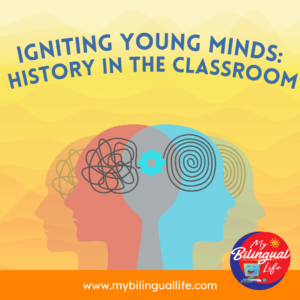Why should we be teaching History in the elementary classroom? In the bustling world of elementary education, the task of teaching history can be both rewarding and challenging. How do we ignite the curiosity of young minds and instill a love for the past in the hearts of our little learners? In this blog post, we’ll explore the joys, strategies, and creative approaches to make the teaching of history an engaging and memorable adventure for elementary students.

Reasons to Teach History in the Elementary Classroom
- Building a Foundation: To introduce history effectively, start by building a strong foundation. Begin with age-appropriate concepts, timelines, and historical figures that capture the imagination of young learners. Use colorful visuals, interactive games, and stories to make the past come alive in a way that resonates with their curious minds.
- Hands-On Learning: Elementary students thrive on hands-on experiences. Create engaging activities like historical reenactments, artifact exploration, and even simple archaeological digs in the classroom. These activities not only make history tangible but also cater to various learning styles, fostering a deeper understanding of historical concepts.
- Storytelling Magic: Harness the power of storytelling to transport students to different eras. Share captivating narratives, historical fiction, or personal stories that connect with the historical content. Encourage students to express their understanding through creative writing, role-playing, or even drawing to develop both their historical knowledge and creative skills.
- Field Trips and Guest Speakers: Take learning beyond the classroom by organizing field trips to local museums, historical sites, or inviting guest speakers. Real-world experiences and firsthand accounts can leave a lasting impression, making history a living, breathing subject rather than a distant chapter in a textbook.
- Integrating Technology: Leverage technology to enhance the learning experience. Interactive websites, virtual tours, and educational apps can make history interactive and entertaining. Incorporate multimedia presentations, documentaries, or virtual reality experiences to bring historical events closer to home for your young historians.
- Connecting History to Everyday Life: Help students see the relevance of history in their daily lives. Explore connections between past and present, encouraging discussions about traditions, inventions, and societal changes. By understanding how history shapes the world around them, students develop a sense of curiosity and appreciation for the subject.
- Celebrating Diversity: Introduce diverse perspectives and cultures into your history lessons. Highlight the contributions of individuals from various backgrounds, ensuring that students see themselves reflected in the stories of the past. This not only promotes inclusivity but also broadens their understanding of the world.
Teaching history in the elementary classroom is a dynamic and inspiring journey. By embracing creativity, hands-on experiences, and a holistic approach, educators can cultivate a love for history that will last a lifetime. Together, let’s embark on this exciting adventure of shaping young minds and fostering a deep appreciation for the rich tapestry of our shared human story.
Challenges to Teaching History in the Classroom
One of the biggest challenges to teaching history in the elementary classroom is the current political climate. School districts around the country are struggling with how history can be taught effectively without causing issues. I’m not going to dig very far into this subject other than to say that despite the opposition from some groups, history still needs to be a part of the curriculum. We must learn from the past and not re-create some of the same problems in our future. As employees of the school district, teachers are expected to follow the guidelines. Any discussion past this point is personal opinion and beliefs and I will not discuss that in this article.
The biggest challenge I had to teaching social studies in my classroom was time. As a bilingual teacher, I had a very short amount of time allotted to teaching social studies daily and it was to be taught in the language of the day. I had very few bilingual materials available to me, so often my lesson plans were not consistent from day to day. This is part of the reason I created the biography resources I have available on my Teachers Pay Teachers store. (Be sure to check out the FREE resource about Martin Luther King, Jr. here!) The resources I created solved the issue of not having equitable resources in both languages. Also, I could use them as “reading passages” and legitimately sneak some social studies into the allotted language arts time.
Finally, the final challenge to teaching history in the elementary classroom is finding resources that stick to the facts. Some resources I have found (especially those generated with artificial intelligence) have facts that are not correct. Also, some resources use history lessons for their own political or social agenda. Teachers need to review their sources before blindly using them in the classroom. Again, this is another reason I created my resources. I could stick to the facts without inserting my own opinions. I also wrote the biographies in a way that would be appropriate for younger students.
Resources for Teaching History in the Classroom
We have created various biography resources that are perfect for Black History Month, Women’s History Month, and Hispanic Heritage Month. We are also working on many other biographies so stay tuned. If there is a biography you would like for your classroom that has not been created yet, feel free to let us know and we will add it to our list!
Be sure to check out our article about 5 reasons to use Biographies in your Classroom.
We also have vocabulary units that cover different cultural holidays. While this isn’t specifically related to history, culture is an important aspect of social studies curriculum and language learning.





